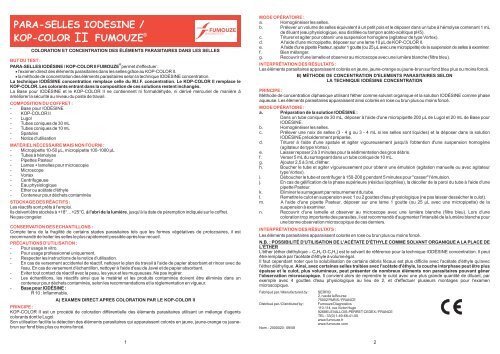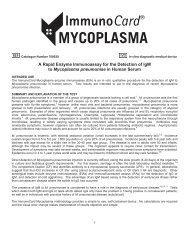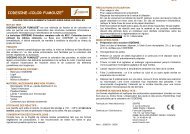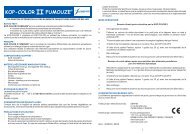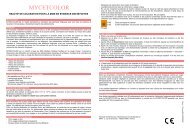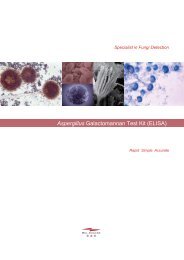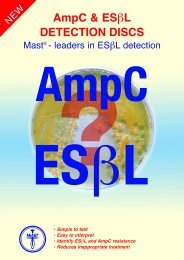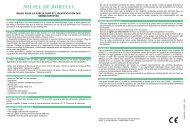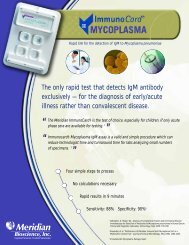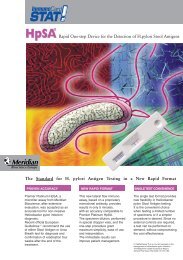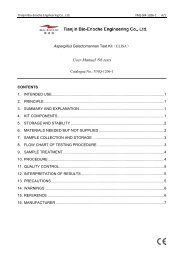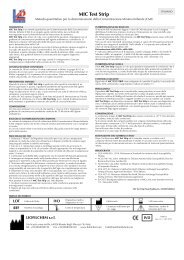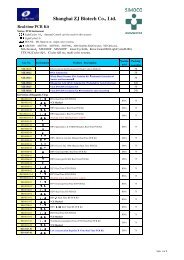para-selles iodesine - Simoco Diagnostics
para-selles iodesine - Simoco Diagnostics
para-selles iodesine - Simoco Diagnostics
You also want an ePaper? Increase the reach of your titles
YUMPU automatically turns print PDFs into web optimized ePapers that Google loves.
PARA-SELLES IODESINE /<br />
KOP-COLOR FUMOUZE<br />
II<br />
®<br />
MODE OPÉRATOIRE :<br />
a. Homogénéiser les <strong>selles</strong>.<br />
b. Prélever un volume de <strong>selles</strong> équivalent à un petit pois et le déposer dans un tube à hémolyse contenant 1 mL<br />
de diluant (eau physiologique, eau distillée ou tampon acéto-acétique pH5).<br />
c. Triturer et agiter pour obtenir une suspension homogène (agitateur de type Vortex).<br />
d. A l'aide d'une micropipette, déposer sur une lame 10 µL de KOP-COLOR II.<br />
e. A l'aide d'une pipette Pasteur, ajouter 1 goutte (ou 25 µL avec une micropipette) de la suspension de <strong>selles</strong> à examiner.<br />
COLORATION ET CONCENTRATION DES ÉLÉMENTS PARASITAIRES DANS LES SELLES f. Bien mélanger.<br />
g. Recouvrir d'une lamelle et observer au microscope avec une lumière blanche (filtre bleu).<br />
BUT DU TEST :<br />
®<br />
INTERPRÉTATION DES RÉSULTATS :<br />
PARA-SELLES IODÉSINE / KOP-COLOR II FUMOUZE permet d'effectuer :<br />
Les éléments <strong>para</strong>sitaires ap<strong>para</strong>issent colorés en jaune, jaune-orange ou jaune-brun sur fond bleu plus ou moins foncé.<br />
l'examen direct des éléments <strong>para</strong>sitaires dans les <strong>selles</strong> grâce au KOP-COLOR II.<br />
la méthode de concentration des éléments <strong>para</strong>sitaires selon la technique IODÉSINE concentration.<br />
B) MÉTHODE DE CONCENTRATION D'ELEMENTS PARASITAIRES SELON<br />
La technique IODÉSINE concentration remplace celle du M.I.F. concentration. Le KOP-COLOR II remplace le<br />
LA TECHNIQUE IODÉSINE CONCENTRATION<br />
KOP-COLOR. Les colorants entrant dans la composition de ces solutions restent inchangés.<br />
La Base pour IODÉSINE et le KOP-COLOR II ne contiennent ni formaldéhyde, ni dérivé mercuriel de manière à PRINCIPE :<br />
améliorer la sécurité au niveau du poste de travail.<br />
COMPOSITION DU COFFRET :<br />
- Base pour IODÉSINE<br />
- KOP-COLOR II<br />
- Lugol<br />
- Tubes coniques de 30 mL<br />
- Tubes coniques de 10 mL<br />
- Spatules<br />
- Notice d'utilisation<br />
MATÉRIEL NÉCESSAIRE MAIS NON FOURNI :<br />
- Micropipette 10-50 µL, micropipette 100-1000 µL<br />
- Tubes à hémolyse<br />
- Pipettes Pasteur<br />
- Lames + lamelles pour microscopie<br />
- Microscope<br />
- Vortex<br />
- Centrifugeuse<br />
- Eau physiologique<br />
- Ether ou acétate d'éthyle<br />
- Conteneur pour déchets contaminés<br />
STOCKAGE DES RÉACTIFS :<br />
Les réactifs sont prêts à l'emploi.<br />
Ils doivent être stockés à +18°…+25°C, à l'abri de la lumière, jusqu'à la date de péremption indiquée sur le coffret.<br />
Ne pas congeler.<br />
CONSERVATION DES ECHANTILLONS :<br />
Compte tenu de la fragilité de certains stades <strong>para</strong>sitaires tels que les formes végétatives de protozoaires, il est<br />
recommandé de traiter les <strong>selles</strong> le plus rapidement possible après leur recueil.<br />
PRÉCAUTIONS D'UTILISATION :<br />
- Pour usage in vitro.<br />
- Pour usage professionnel uniquement.<br />
- Respecter les instructions de la notice d'utilisation.<br />
- En cas de versement accidentel de réactif, nettoyer le plan de travail à l'aide de papier absorbant et rincer avec de<br />
l'eau. En cas de versement d'échantillon, nettoyer à l'aide d'eau de Javel et de papier absorbant.<br />
- Eviter tout contact de réactif avec la peau, les yeux et les muqueuses. Ne pas ingérer.<br />
- Les échantillons, les réactifs ainsi que le matériel et les produits contaminés doivent être éliminés dans un<br />
conteneur pour déchets contaminés, selon les recommandations et la réglementation en vigueur.<br />
- Base pour IODÉSINE :<br />
R 10 : Inflammable.<br />
A) EXAMEN DIRECT APRES COLORATION PAR LE KOP-COLOR II<br />
PRINCIPE :<br />
KOP-COLOR II est un procédé de coloration différentielle des éléments <strong>para</strong>sitaires utilisant un mélange d'agents<br />
colorants dont le Lugol.<br />
Son utilisation facilite la détection des éléments <strong>para</strong>sitaires qui ap<strong>para</strong>issent colorés en jaune, jaune-orange ou jaunebrun<br />
sur fond bleu plus ou moins foncé.<br />
Méthode de concentration diphasique utilisant l'éther comme solvant organique et la solution IODÉSINE comme phase<br />
aqueuse. Les éléments <strong>para</strong>sitaires ap<strong>para</strong>issent ainsi colorés en rose ou brun plus ou moins foncé.<br />
MODE OPÉRATOIRE :<br />
a. Pré<strong>para</strong>tion de la solution IODÉSINE :<br />
Dans un tube conique de 30 mL, déposer à l'aide d'une micropipette 200 µL de Lugol et 20 mL de Base pour<br />
IODÉSINE.<br />
b. Homogénéiser les <strong>selles</strong>.<br />
c. Prélever une noix de <strong>selles</strong> (3 - 4 g ou 3 - 4 mL si les <strong>selles</strong> sont liquides) et la déposer dans la solution<br />
IODÉSINE précédemment préparée.<br />
d. Triturer à l'aide d'une spatule et agiter vigoureusement jusqu'à l'obtention d'une suspension homogène<br />
(agitateur de type Vortex).<br />
e. Laisser reposer 2 à 3 minutes pour la sédimentation des gros débris.<br />
f. Verser 5 mL du surnageant dans un tube conique de 10 mL.<br />
g. Ajouter 2,5 à 3 mL d'éther.<br />
h. Boucher le tube et agiter vigoureusement pour obtenir une émulsion (agitation manuelle ou avec agitateur<br />
type Vortex).<br />
i. Déboucher le tube et centrifuger à 150-200 g pendant 5 minutes pour "casser" l'émulsion.<br />
j. En cas de gélification de la phase supérieure (résidus lipophiles), la décoller de la paroi du tube à l'aide d'une<br />
pipette Pasteur.<br />
k. Eliminer le surnageant par retournement du tube.<br />
l. Remettre le culot en suspension avec 1 ou 2 gouttes d'eau physiologique (ne pas laisser dessécher le culot).<br />
m. A l'aide d'une pipette Pasteur, déposer sur une lame 1 goutte (ou 25 µL avec une micropipette) de la<br />
suspension à examiner.<br />
n. Recouvrir d'une lamelle et observer au microscope avec une lumière blanche (filtre bleu). Lors d'une<br />
coloration trop importante des <strong>para</strong>sites, il est recommandé d'augmenter l'intensité de la lumière blanche pour<br />
une bonne observation microscopique de ces derniers.<br />
INTERPRÉTATION DES RÉSULTATS :<br />
Les éléments <strong>para</strong>sitaires ap<strong>para</strong>issent colorés en rose ou brun plus ou moins foncé.<br />
N.B. : POSSIBILITÉ D'UTILISATION DE L'ACÉTATE D’ÉTHYLE COMME SOLVANT ORGANIQUE A LA PLACE DE<br />
L'ÉTHER<br />
L'éther (éther diéthylique – C2H5-O-C2H 5) est le solvant de référence pour la technique IODÉSINE concentration. Il peut<br />
être remplacé par l'acétate d'éthyle à volume égal.<br />
Il faut cependant noter que la solubilisation de certains débris fécaux est plus difficile avec l'acétate d'éthyle qu'avec<br />
l'éther diéthylique. Ainsi, avec certaines <strong>selles</strong> traitées avec l'acétate d'éthyle, la couche interphase peut être plus<br />
épaisse et le culot, plus volumineux, peut présenter de nombreux éléments non <strong>para</strong>sitaires pouvant gêner<br />
l'observation microscopique. Il convient alors de reprendre le culot avec une plus grande quantité de diluant, par<br />
exemple avec 4 gouttes d'eau physiologique au lieu de 2, et d'effectuer plusieurs montages pour l'examen<br />
microscopique.<br />
Fabriqué par / Manufactured by :<br />
Distribué par / Distributed by :<br />
Nom. : 2000020 - 09/08<br />
SERFIB<br />
2, rue de la Bourse<br />
75002 PARIS / FRANCE<br />
Fumouze <strong>Diagnostics</strong><br />
110-114, rue Victor Hugo<br />
92686 LEVALLOIS-PERRET CEDEX / FRANCE<br />
TEL : 33(0) 1-49-68-41-00<br />
www.fumouze.fr<br />
www.fumouze.com<br />
1 2
PARA-SELLES IODESINE /<br />
KOP-COLOR FUMOUZE<br />
II<br />
STAINING AND CONCENTRATION OF PARASITIC ELEMENTS IN STOOLS<br />
INTENDED USE:<br />
®<br />
PARA-SELLES IODESINE / KOP-COLOR II FUMOUZE allows performing:<br />
the direct examination of <strong>para</strong>sitic elements in stools with the KOP-COLOR II.<br />
the concentration of <strong>para</strong>sitic elements based on IODESINE concentration method.<br />
The IODESINE concentration technique replaces the M.I.F. Concentration one. KOP-COLOR II replaces KOP-COLOR.<br />
The staining agents used are the same.<br />
The Base for IODESINE and KOP-COLOR II contain neither formalin nor mercury derivative so as to improve work station safety.<br />
c. Triturate and shake it to obtain a homogeneous suspension (Vortex shaker).<br />
d. Using the micropipette, place 10 µL of KOP-COLOR II on a slide.<br />
e. Using the Pasteur pipette, add 1 drop (or, using the micropipette, add 25 µL) of the stools suspension to examine.<br />
f. Mix well.<br />
g. Place a coverglass over the stools suspension and examine by using a microscope having a white light (blue filter).<br />
INTERPRETATION OF THE RESULTS:<br />
Parasitic elements appear to be yellow, yellow-orange or brownish-yellow on a more or less dark blue background.<br />
B) CONCENTRATION OF PARASITIC ELEMENTS BASED ON<br />
IODESINE CONCENTRATION METHOD<br />
PRINCIPLE:<br />
Two phase method of concentration using ether as an organic solvent and the IODESINE solution as the aqueous phase.<br />
Parasitic elements appear to be pink or more or less darkish brown.<br />
TEST PROCEDURE:<br />
a. IODESINE solution pre<strong>para</strong>tion :<br />
Place 200 µL of Lugol in the bottom of a 30 mL conical tube, then add 20 mL of Base for IODESINE.<br />
KIT CONTENT:<br />
- Base for IODESINE b. Homogenize the stools.<br />
- KOP-COLOR II c. Take out the equivalent of a knob of the stools (3 to 4 g or 3 to 4 mL if the stools are fluid) and place it in the previously<br />
- Lugol prepared IODESINE solution.<br />
- Conical tubes of 30 mL d. Triturate the stools by using a spatula and shake the mixture vigorously until a homogeneous suspension is obtained<br />
- Conical tubes of 10 mL (Vortex shaker).<br />
- Spatulas e. Permit the mixture to settle for 2 or 3 minutes for the sedimentation of the coarser particles.<br />
- Package insert f. Pour 5 mL of supernatant in a 10 mL conical tube.<br />
g. Add 2.5 to 3 mL of ether.<br />
h. Plug the tube and shake vigorously to obtain an emulsion (shake manually or with a Vortex shaker).<br />
MATERIAL REQUIRED BUT NOT PROVIDED:<br />
- Micropipette 10-50 µL, micropipette 100-1000 µL i. Take the plug out of the tube and centrifuge the mixture (150-200 g) for 5 minutes to "break" the emulsion.<br />
- Haemolysis tubes j. In the case of gelling in the higher phase (due to lipophile residues), loosen the emulsion from the tube walls using the<br />
- Pasteur pipettes Pasteur pipette.<br />
- Slides + coverglasses for microscopy k. Eliminate the supernatant by turning the tube upside down.<br />
- Microscope l. Put the sediment in a suspension using 1 or 2 drops of physiological saline (do not allow the sediment to dry up).<br />
- Vortex m. Using the Pasteur pipette, place 1 drop (or, using the micropipette, add 25 µL) of the suspension to examine on a slide.<br />
- Centrifuge n. Place a coverglass over the sediment suspension and examine under a microscope using a white light (blue filter).<br />
- Physiological saline When <strong>para</strong>sites colouring is too important, it is recommended to increase the white light intensity for a good<br />
- Ether or ethyl acetate microscopic observation of these last ones.<br />
- Container for contaminated wastes<br />
STORAGE CONDITIONS:<br />
Reagents are ready-to-use.<br />
Store at +18°…+25°C, sheltered from sunlight, until the expiry date indicated on the box. Do not freeze.<br />
SAMPLES STORAGE:<br />
Due to the fragility of some of <strong>para</strong>sitic stages as protozoa vegetative forms, it is recommended to treat stools as soon as possible<br />
after their collection.<br />
INTERPRETATION OF THE RESULTS:<br />
Parasitic elements appear to be pink or more or less darkish brown.<br />
N.B.: POSSIBILITY OF USING ETHYL ACETATE AS ORGANIC SOLVENT INSTEAD OF ETHER<br />
Ether (diethyl ether – C2H 5 – O – C2H 5) is the reference solvent for IODESINE concentration method. It can be replaced by ethyl<br />
acetate in equal volume.<br />
It is however necessary to note that the solubilisation of certain faecal fragments is more difficult with ethyl acetate than with<br />
diethyl ether. So, with certain stools treated with ethyl acetate, the interface layer may be thicker and the more<br />
voluminous sediment may present numerous non-<strong>para</strong>sitic elements which may hamper microscopic observation. It is<br />
WARNINGS AND PRECAUTIONS:<br />
- For in vitro diagnostic use. then advisable to take back the sediment with more diluent, for example with 4 drops of physiological water instead of 2, and to<br />
- Only for professional use. make several assemblies for the microscopic examination.<br />
- Follow the instructions for use.<br />
- In case of accidental spill of reagents, clean the surface with absorbent paper and water. In case of spill of sample, clean the<br />
surface with absorbent paper and bleach.<br />
- Avoid contact of reagent with skin, eyes and mucous membranes. Do not ingest.<br />
BIBLIOGRAPHIE / REFERENCES :<br />
- The samples, reagents as well as contaminated materials and products must be eliminated in a container for contaminated 1. A. O'FEL - Parasitologie mycologie - Format Utile, Saint-Maur.<br />
wastes, according to the prevailing recommendations and regulations.<br />
2. J. BAILENGER - Coprologie <strong>para</strong>sitaire et fonctionnelle - Imprimerie Drouillard, Bordeaux.<br />
- Base for IODESINE:<br />
3. P. BOURÉE - Aide mémoire de <strong>para</strong>sitologie - Flammarion, Paris.<br />
4. A.-M. DELUOL - Atlas de <strong>para</strong>sitologie - Guide pratique du diagnostic au microscope - (tomes I, II, III). Edition Varia, Paris.<br />
R 10: Flammable. 5. J.-P. NOZAIS, A. DATRY, M. DANIS, C. BOUDON - Traité de <strong>para</strong>sitologie médicale - Pradel, Paris.<br />
6. M. GENTILLINI, B. DUFLO - Médecine tropicale de voyage - Flammarion Médecine Sciences, Paris.<br />
A) DIRECT EXAMINATION AFTER STAINING BY KOP-COLOR II 7. Y.-J. GOLVAN - Eléments de <strong>para</strong>sitologie médicale - Flammarion, Paris.<br />
TEST PROCEDURE:<br />
a. Homogenize stools.<br />
b. Take out a volume of stools equivalent to the size of a pea and place it in a haemolysis tube containing 1 mL of thinner<br />
(physiological saline, distilled water or pH5 aceto-acetate buffer solution).<br />
®<br />
8. H. LEGER, M.-J. NOTTEGHEM - Guide de <strong>para</strong>sitologie pratique - SEDES, Paris.<br />
9. C. JUNOD - Recherche spéciale des oeufs et larves d'Helminthes dans les <strong>selles</strong> par la méthode des concentrations<br />
PRINCIPLE:<br />
KOP-COLOR II is a differential staining process of <strong>para</strong>sitic elements using a mixture of staining agents one of which is Lugol. combinées - Feuillets de biologie, 92 : 55-62 (1976).<br />
Its utilization facilitates the detection of <strong>para</strong>sitic elements which appear to be yellow, yellow-orange or brownish-yellow on a more 10. D. ENGELS, S. NAHIMANA, B. GRYSEELS - Comparison of the direct faecal smear and two thick smear techniques for the<br />
or less dark blue background.<br />
diagnosis of intestinal <strong>para</strong>sitic infections - Transactions of the Royal Society of Tropical Medecine and Hygiene, 90 : 523-<br />
525 (1996).<br />
3 4


